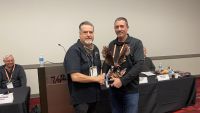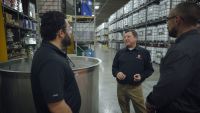Contractor to Contractor: Keystone Masonry, Inc.
By Masonry
Keystone Masonry, Inc. started out in November of 1987, primarily working on residential construction, as well as small or light commercial. They moved into commercial work in the early '90s, and are now looking to branch out into custom, high-end stonework. We spoke with Borman just after a Masonry Institute of Washington meeting, in conjunction with the Washington State Contractors of Masonry Contractors, to standardize the details used by architects in employing masonry products in their buildings. "If successful, and I think we will be, in standardizing those details, architects who might choose to design with our products will be more inclined to use them," says Borman.
Masonry: What do you feel has been the key to your company's success and growth over the years?
Borman: Basically, success is a result of completing projects on schedule and maintaining the standard of quality that is required, not only by the architect and owner, but by the industry itself. If a contractor can meet those requirements, both in scheduling and quality, then they're bound to be successful. Oftentimes, there's a conflict between schedule and quality — that's an on-going problem that everyone addresses in their own fashion.
Masonry: Keystone has won two awards at the Masonry Institute of Washington's 2002 Masonry Excellence Awards in November. Tell us a little more about these projects and what you feel made them stand out as award-winning work.
Borman: They were difficult projects, and we often like to focus on the more difficult projects. For instance, Hazen High School's auditorium was a large, radius structure. Both the CMU and the brick needed to be laid in a radius, which is often a challenging task to keep your vertical and horizontal lines true. It's obviously the most salient feature of the building and it's quite attractive because of that. Using masonry to create curves is an interesting challenge. If it's done well, it adds a whole new dimension to masonry construction. The key is having highly skilled craftsmen doing the work.
The eye-catcher on the Western State Hospital is the inset panels over the first floor windows. The brickwork is laid diagonally at 45 degrees, and that presented a compelling challenge. A good portion of the units laid were mitered. Aligning all of those miters is a difficult task. To achieve this, we fabricated those inset panels in our construction yard. It allowed us to conduct simultaneous activities, both onsite and offsite — we were building the panels, while we were running up the brick veneer in the field. We trucked the panels to the job site and bolted them to the backup CMU wall. It was a measure that we took to maintain a high quality of work while expediting the schedule.
Masonry: In addition to these awards, Keystone has won last year as well. How has this affected your business?
Borman: It's prestigious to win awards for quality craftsmanship, certainly. Most of the work that Keystone acquires is hard bid work, so regardless of how many awards you've won, you still have to be the low bidder to get the next job on public works projects, even in the private sector. I think the greatest effect is the prestige that it affords the craftsmen who work for us and do the work onsite. If they go to the awards ceremony with us and they are presented an award for their craftsmanship, it only encourages them to maintain that level of quality on future projects. I haven't necessarily acquired a great deal of work as a result of having won awards. This is not true for architects, however, hence the design awards are primarily for them.
Masonry: Keystone Masonry is now investing in a website design. What made you come to the decision to invest in a website and how do you plan on using it now and in the future?
Borman: Keystone is moving increasingly into custom stonework on commercial, as well as high-end residential, projects — we now have a crew of stonemasons who exclusively perform stonework. The Internet is often where clients look for information on contractors who do that type of work, and we're hoping to develop that market. I'm a stonemason by trade and have hoped for many years to develop a niche in the custom stonework market.
Masonry: What do you feel is the biggest misconception about the masonry industry?
Borman: I've thought for some time, and my beliefs were reinforced recently with the earthquake we had in Seattle, that one of the major misconceptions — perhaps the biggest — is that masonry doesn't withstand seismic forces. That's because, if there is an earthquake or some major seismic event, the press is out in force taking pictures of bricks that are lying on the sidewalk. Most of those structures that suffer damage from earthquakes were built before the days of reinforced masonry.
I think it's important that the public be educated about the performance and abilities of reinforced masonry. The press doesn't go around taking pictures of buildings that successfully withstood those seismic forces — only the ones that are damaged. We get a bad rap as a result of that and I would like to see that change. I think we need more information put out for the public to understand the abilities of masonry to withstand these seismic events.
Masonry: What would you do to change that misconception?
Borman: Through promotion — promotion of our products and the performance of our systems.
Masonry: What are your two biggest concerns in keeping your company successful?
Borman: The first relates to, of course, market share. There has to be enough work to go around. The only way that we can attain that is to develop more business, to develop a larger market share. That brings in the need to develop promotion within the industry. I think it's really the responsibility of the contractors, as well as organized labor, to lend a hand in promoting the use of masonry. This will insure there will be plenty of work for us all in the future.
The second concern is training. I think we're all witnessing an aging of our workforce. It's a fact that there aren't as many young people entering our trade as we'd like to see. I think now is a perfect opportunity, with the downturn of the economy nationwide, to try to entice young people into our trade. They can certainly make a good living in this trade. I think that young people entering the job market now might be more receptive to a career in construction than they would have a couple of years ago.
Those two things — promotion and training — are the two things that I not only need to maintain our level of success, but the industry also needs as a whole.
Masonry: Do you feel that architects are informed and educated enough in masonry products?
Borman: No, I don't feel that they are. Since the architects are not required to build with masonry, they're not necessarily trained in the best use of masonry.
Let me give you a little history here... The masonry industry in this country changed dramatically with the World's Fair in 1893, when the Industrial Revolution and the development of the ability to build steel structures, rather than multi-wythe masonry structures, first really affected our industry. We lost a great deal of the market that we had, which was pretty extensive. It was only inevitable that that this would happen.
It didn't take long for masonry to recover to some extent because by the 1920s Frank Lloyd Wright was using reinforced concrete unit masonry in Southern California. But nonetheless, buildings are built taller and the frames are lighter than they were in the past.
So, for the most part, other than the retail stores and schools, masonry has become an architectural item rather than a structural one. I think we need to speak to the engineers as well and gain their confidence in the performance of masonry systems and recapture a greater share of the market.
Masonry: What do you think will be the masonry industry's biggest competitor in 10 years?
Borman: It's hard to say. We have to be on our toes, though, to develop new systems — new cavity wall systems — that will meet the requirements of the projects that architects are designing. And we have to respond to every other new technology that arises with one of our own to counter their efforts to acquire our market share.
Masonry: What do you feel are the most critical issues you'll face with future government regulations?
Borman: Well, certainly ergonomics is one of them. The Federal government has agreed to back away from this issue for a time, but we still have to deal with it on a state level. Washington state is moving ahead with ergonomics. I think some of the ergonomic requirements are unreasonable. I don't believe that someone who works in the construction industry, or any industry, should expect to retire at 50 or 60 years old with the same body that they had when they were 19.
I feel the ergonomics regulations, if they're not mitigated by involvement of people within the construction industry, could have a devastating effect on our ability to deliver quality projects on schedule and within cost.
Masonry: Which group do you feel has the bigger impact on masonry's future, architects, engineers, or general contractors?
Borman: Architects, certainly — the design begins with the architect. The engineer generally offers input, of course, but he or she will engineer the building according to the architect's design. If the architect has chosen to use CMU, then the engineer will provide the information and the data required to complete that design. So, our promotion efforts need to be directed toward architects, primarily.
General contractors, to some extent, have involvement when they do design-build projects. Oftentimes, general contractors use their own workforce to do the concrete work and we often see buildings that might otherwise be CMU go to tilt-up concrete. It depends, too, on the economy. If there's a lot of work, the general contractor will sub it out to CMU; if the GC needs the work to keep his or her workforce going, it'll turn into a tilt-up concrete job.
Masonry: What do you like most about being a member of MCAA?
Borman: What I really like the most is the access to the literature that they have in the library. Oftentimes, problems develop on job sites and we need to substantiate the means and methods that are industry standards within the masonry industry. On several occasions, I have looked to MCAA to provide the documentation that I need to substantiate my claims.
About the Author
Masonry, the official publication of the Mason Contractors Association of America, covers every aspect of the mason contractor profession - equipment and techniques, building codes and standards, business planning, promoting your business, legal issues and more. Read or subscribe to Masonry magazine at www.masonrymagazine.com.


















